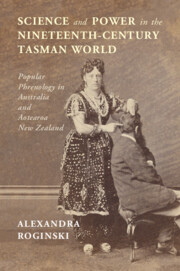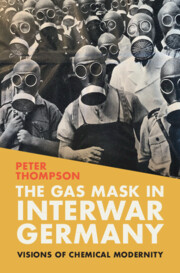Refine search
Actions for selected content:
10296 results in History of science: general interest
Dedication
-
- Book:
- The Gas Mask in Interwar Germany
- Published online:
- 11 May 2023
- Print publication:
- 25 May 2023, pp v-vi
-
- Chapter
- Export citation
6 - Technologies of Fate: Cultural and Intellectual Prophesies of the Future Gas War
-
- Book:
- The Gas Mask in Interwar Germany
- Published online:
- 11 May 2023
- Print publication:
- 25 May 2023, pp 179-213
-
- Chapter
- Export citation
4 - The Limits of Sympathy: The Medical Treatment of Poison Gas during and after World War I
-
- Book:
- The Gas Mask in Interwar Germany
- Published online:
- 11 May 2023
- Print publication:
- 25 May 2023, pp 105-131
-
- Chapter
- Export citation
5 - Atmos(fears): The Poison Gas Debates in the Weimar Republic
-
- Book:
- The Gas Mask in Interwar Germany
- Published online:
- 11 May 2023
- Print publication:
- 25 May 2023, pp 132-178
-
- Chapter
- Export citation
Abbreviations
-
- Book:
- The Gas Mask in Interwar Germany
- Published online:
- 11 May 2023
- Print publication:
- 25 May 2023, pp xii-xii
-
- Chapter
- Export citation
Contents
-
- Book:
- The Gas Mask in Interwar Germany
- Published online:
- 11 May 2023
- Print publication:
- 25 May 2023, pp vii-vii
-
- Chapter
- Export citation
3 - The First “Chemical Subjects”: Soldier Encounters with the Gas Mask in World War I
-
- Book:
- The Gas Mask in Interwar Germany
- Published online:
- 11 May 2023
- Print publication:
- 25 May 2023, pp 75-104
-
- Chapter
- Export citation
Conclusion
-
- Book:
- The Gas Mask in Interwar Germany
- Published online:
- 11 May 2023
- Print publication:
- 25 May 2023, pp 280-287
-
- Chapter
- Export citation
Tables
-
- Book:
- The Gas Mask in Interwar Germany
- Published online:
- 11 May 2023
- Print publication:
- 25 May 2023, pp ix-ix
-
- Chapter
- Export citation
2 - The Man in the Rubber Mask: World War I and the Development of the Modern Gas Mask
-
- Book:
- The Gas Mask in Interwar Germany
- Published online:
- 11 May 2023
- Print publication:
- 25 May 2023, pp 54-74
-
- Chapter
- Export citation
Index
-
- Book:
- The Gas Mask in Interwar Germany
- Published online:
- 11 May 2023
- Print publication:
- 25 May 2023, pp 323-328
-
- Chapter
- Export citation
Copyright page
-
- Book:
- The Gas Mask in Interwar Germany
- Published online:
- 11 May 2023
- Print publication:
- 25 May 2023, pp iv-iv
-
- Chapter
- Export citation
Hans Radder, From Commodification to the Common Good: Reconstructing Science, Technology and Society Pittsburgh: University of Pittsburgh Press, 2019. Pp. 312. ISBN 978-0-8229-4579-6. $50.00 (hardcover).
-
- Journal:
- The British Journal for the History of Science / Volume 56 / Issue 2 / June 2023
- Published online by Cambridge University Press:
- 24 May 2023, pp. 271-273
- Print publication:
- June 2023
-
- Article
- Export citation
Van Leeuwenhoek – the film: remaking memory in Dutch science cinema 1925–c.1960
-
- Journal:
- The British Journal for the History of Science / Volume 56 / Issue 3 / September 2023
- Published online by Cambridge University Press:
- 22 May 2023, pp. 329-349
- Print publication:
- September 2023
-
- Article
-
- You have access
- Open access
- HTML
- Export citation

Science and Power in the Nineteenth-Century Tasman World
- Popular Phrenology in Australia and Aotearoa New Zealand
-
- Published online:
- 18 May 2023
- Print publication:
- 01 June 2023
Representing noise: stacked plots and the contrasting diplomatic ambitions of radio astronomy and post-punk
-
- Journal:
- The British Journal for the History of Science / Volume 56 / Issue 2 / June 2023
- Published online by Cambridge University Press:
- 18 May 2023, pp. 225-245
- Print publication:
- June 2023
-
- Article
-
- You have access
- Open access
- HTML
- Export citation
Cesare Cremonini's non-theological cosmology: a contribution to Padua's secular culture in times of wars of religion
-
- Journal:
- The British Journal for the History of Science / Volume 57 / Issue 4 / December 2024
- Published online by Cambridge University Press:
- 17 May 2023, pp. 561-579
- Print publication:
- December 2024
-
- Article
-
- You have access
- Open access
- HTML
- Export citation

The Gas Mask in Interwar Germany
- Visions of Chemical Modernity
-
- Published online:
- 11 May 2023
- Print publication:
- 25 May 2023
Picturing Chinese science: wartime photographs in Joseph Needham's science diplomacy
-
- Journal:
- The British Journal for the History of Science / Volume 56 / Issue 2 / June 2023
- Published online by Cambridge University Press:
- 04 May 2023, pp. 185-203
- Print publication:
- June 2023
-
- Article
-
- You have access
- Open access
- HTML
- Export citation
How did a Lutheran astronomer get converted into a Catholic authority? The Jesuits and their reception of Tycho Brahe in Portugal
-
- Journal:
- The British Journal for the History of Science / Volume 57 / Issue 4 / December 2024
- Published online by Cambridge University Press:
- 02 May 2023, pp. 581-602
- Print publication:
- December 2024
-
- Article
- Export citation
